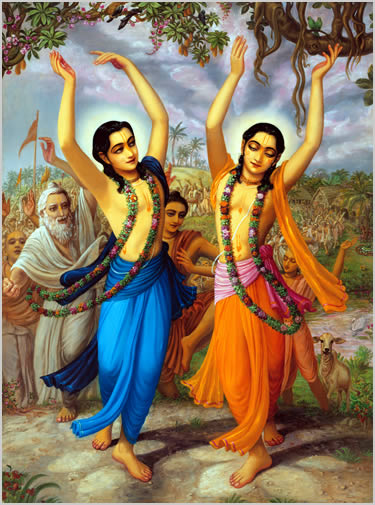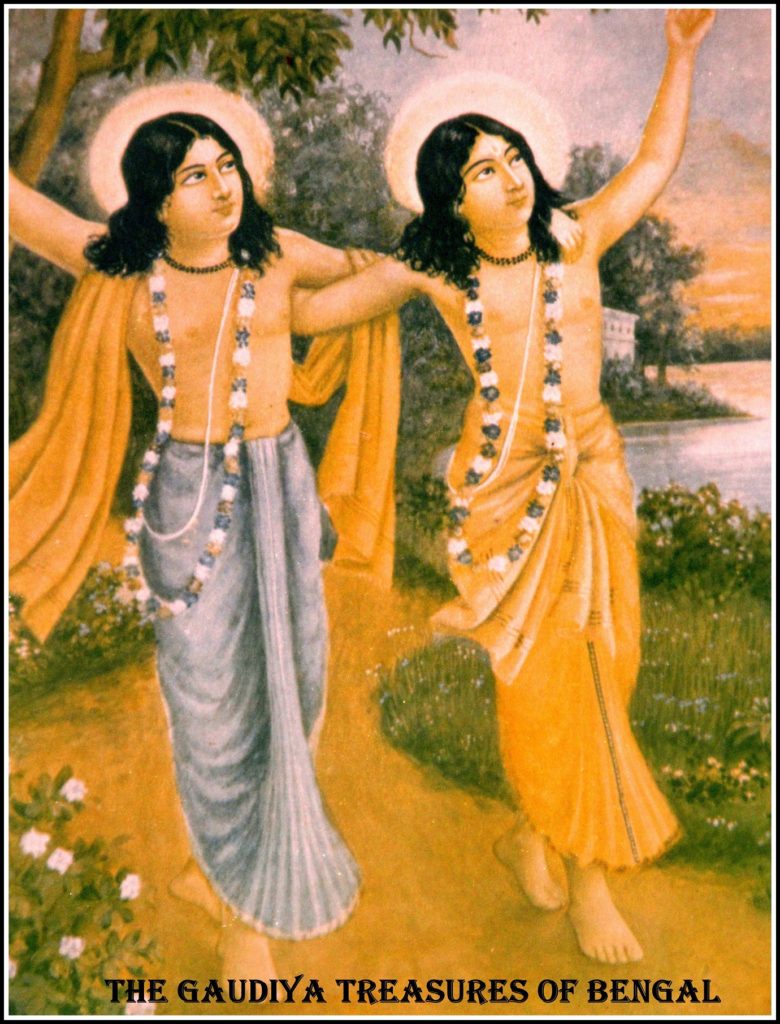
In this article, we intend to ascertain the exact year of Lord Nityananda’s birth. Lord Nityananda was none other than Lord Balarama who had appeared to assist Sri Chaitanya Mahaprabhu (who was Krishna Himself) in manifesting His magnanimous sankirtana pastimes. Though it has been well established that Lord Nityananda had appeared in the village of Ekachakra situated in the Birbhum district of West Bengal and that He was born on a trayodashi (thirteenth day of the Lunar fortnight), yet the exact date or even the year of His birth remains unconfirmed till this day. After examining the subject in detail, we have narrowed it down to two possible outcomes based upon the information contained in bonafide texts. If one goes by the valuable information presented in Sri Chaitanya Bhagavata and Bhakti Ratnakara, Lord Nityananda’s year of birth is ascertained to be 1478 AD (or the year 1399 of Saka era). On the other hand, the information provided in ancient texts like Advaita Prakash and books by some other authors infers that Lord Nityananda was born in 1474 AD ( year 1395 of the Saka era). We shall address both of these scenarios below in detail.
Scenario 1 : Lord Nityananda’s year of birth is 1478 AD (year 1399 of Saka era)
Sri Chaitanya Bhagavata, composed by Srila Vrindavana das Thakura, the dear disciple of Lord Nityananda, is deemed to be one of the most authoritative and bonafide Gaudiya Vaishnava literatures. Sri Chaitanya Bhagavata confirms that Lord Nityananda had stayed in His home for twelve years after which he had left for pilgrimage. During His pilgrimage, He traveled widely for twenty years. Eventually, He met with Lord Chaitanya at Nabadwip.
Henomate Dvadasa vatsara thhaki ghare
Nityananda chalilena tirtha karibare
Tirtha-yatra karilen Bingsati vatsara
tabe seshe ailena Chaitanya gochara
(Chaitanya Bhagavata, adi, 9.100-101)
–
Lord Nityananda remained at home for twelve years, continuously manifesting such (wonderful) pastimes. Thereafter He left on pilgrimage. He traveled to different places of pilgrimage for twenty years. Then, at last, He met with Sri Chaitanya Mahaprabhu.
Sri Bhakti Ratnakara, composed by Sri Narahari Chakravarti, also supports the above narrative. The Bhakti Ratnakara states –
Nityananda baraiya sabara piriti
Dvadasha vatsara Grihe karilena sthhiti
Bingsati vatsara kaila Tirtha paryatana
Yatha ye vilasa taha ke karu varnana
(Bhakti Ratnakara)
–
Lord Nityananda stayed at home for twelve years and thereby intensified everyone’s love for Him.
Thereafter, He traveled on pilgrimage for twelve years. Who can possibly describe the innumerable places he visited and the pastimes He exhibited during this time?
Hence, proceeding with this line of evidence, one gathers that Lord Nityananda stayed in His hometown for twelve years. Thereafter, He went on an extensive pilgrimage for twenty more years before eventually meeting with Lord Chaitanya. Therefore, it can be inferred that Lord Nityananda was thirty-two years of age when He met with Chaitanya Mahaprabhu.

Also, it is well known that Sri Chaitanya had accepted His sannyasa (renounced order of life) shortly after meeting with Lord Nityananda. Sri Chaitanya Mahaprabhu was twenty-four years of age at that time when He had accepted the renounced order. Also, that Sri Chaitanya was born in the year 1407 Shaka era (1486 AD) is a well-established fact. We are presenting relevant evidence from Sri Chaitanya Charitamrita that verifies the same.
chaudda-shata saath sake janmera pramana
chaudda-shata panchanne haila antardhana
(Chaitanya Charitamrita, Adi, 13.9)
–
Sri Chaitanya Mahaprabhu appeared in this world in the year 1407 of the Saka era (1486 AD) and He disappeared from this world in the 1455 year of the Saka era (1534 AD).
Again, the Chaitanya Charitamrita confirms –
chobbisa vatsara seshe yei magha masha
tara sukla-pakshe prabhu karila sannyasa
(Chaitanya Charitamrita, Madhya, 1.16)
–
At the end of His twenty-fourth year, in the month of Magha, during the fortnight of the waxing moon, Lord Chaitanya accepted sannyasa (the renounced order of life).
As previously stated, Lord Nityananda met with Chaitanya Mahaprabhu when He was thirty-two years of age. It was the day before Guru-Purnima in the month of Asadha (June-July) when their meeting took place. This statement is confirmed in Chaitanya Bhagavata wherein Sri Chaitanya asks Nityananda Prabhu the below question on the very day of their meeting –
Shuno shuno Nityananda Sripada Gosai
Vyasa puja tomara haibe kon thaain?
Kaali haibe Paurnamasi Vyasera pujana
Apane bujhiya bala, yare laya mon
(Chaitanya Bhagavata, Madhya, 5.8-9)
–
Listen, My dear Nityananda Goswami, where shall Your ‘Vyasa puja’ be celebrated? Tomorrow there is a full moon, and it is on this day that Srila Vyasadeva is worshiped. So You may choose any one, and make arrangements with him.
Therefore, we have gathered till now that Lord Nityananda had met with Lord Chaitanya when he was thirty two years of age and that they had met on the day before Guru-Purnima in the month of Asada (June-July). It was a few months later, in the month of Magha (January-February) that Sri Chaitanya had accepted His sannyasa initiation. As stated before, Sri Chaitanya was born in the year 1407 of the Saka era and He was twenty-four years of age when He accepted the renounced order.

Hence, it was the year 1431 of the Saka era when Lord Chaitanya accepted His sannyasa. Lord Nityananda was thirty-two years of age at this time as has been discussed previously. Hence, going by this calculation, Lord Nityananda had appeared in the year 1399 of the Saka era. He was born in the month of Magha on the Shukla Trayodashi tithi.
Magh mashe Shukla Trayodashi shuvo dine
Padmavati Garbhe Ekchaka nama Grame
(Chaitanya Bhagavata, Adi,2.129)
–
Lord Nityananda made his appearance from the womb of Srimati Padmavati devi on the auspicious thirteenth day of the waxing moon in the month of Magha at a village called Ekachakra.
Hence as per the pieces of evidence we obtain from Sri Chaitanya Bhagavata, Bhakti Ratnakara, and Chaitanya Charitamrita, it is to be construed that Lord Nityananda had appeared on the Shukla Trayodashi tithi of Magha in the year 1399 of the Saka era which corresponds to January-February of the year 1478 AD.
Scenario 2: Lord Nityananda’s year of birth is 1474 AD (year 1395 of Saka era)
Let us now discuss the second scenario. Isana Nagara mentions in his Advaita Prakash that –
Tyero-shata pancha-nabboi Sake Magha mashe
Shukla Trayodashite Ramera prakashe
(Advaita Prakash)
–
Sri Nityananda Rama had appeared in the year 1395 of the Saka era on the auspicious occasion of Shukla Trayodashi (thirteenth day of the waxing moon).
The word ‘Rama’ in the above verse refers to Nityananda who is none other than Lord Balarama. Different authors like Haridasa das, Janakinatha Pal, Sri Kshirod Bihari Goswami, Sri Prabhatchand Goswami, Rakhal das Bandopadhyay, etc. also accept the date specified in Advaita Prakash. So clearly the information contained in Advaita Prakash had inspired and influenced them. Hence, going by this line of consideration, we can infer that Lord Nitai had appeared in this world on Magha (January-February) in the year 1395 of the Saka era, which corresponds to 1474 AD.
Conclusion
The Magha (January-February) of either 1474 AD or 1478 AD are the auspicious years in which our beloved Nitai had appeared in this world. He was born on ‘Shukla trayodashi tithi’ (thirteenth day of the Lunar fortnight) in the holy land of Birbhum, West Bengal. We have placed all the facts and evidence before you and now it is entirely your choice to pick amongst the two dates you would want to believe in. As stated above, Sri Advaita Prakash quotes Lord Nityananda’s exact year of birth (the year 1395 of the Saka era or 1474 AD) in one of its verses and this has subsequently played a significant role in shaping the verdict of a vast majority of scholars. However, personally, we hold that Lord Nityananda was born in 1478 AD (the year 1399 of the Saka era) instead. It is because the evidence contained in Chaitanya Bhagavata, Bhakti Ratnakara, and Chaitanya Charitamrita seem too powerful to deny. Ascertaining Lord Nityananda’s year of birth to be 1478 AD requires quite a bit of cross-referencing and involves a few intricate calculations (presented above). We believe that this might be one of the reasons why the year 1478 AD went largely overlooked as Lord Nitai’s year of birth. However, the audience is hereby advised not to be influenced by our personal opinion and is encouraged to examine all the facts before concluding.
